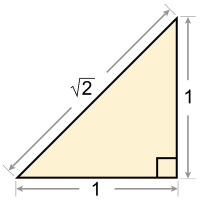Definable Real Number
Informally, a definable real number is a real number that can be uniquely specified by its description.
The description may be expressed as a construction or as a formula of a formal language. For example, the positive square root of 2, , can be defined as the unique positive solution to the equation , and it can be constructed with a compass and straightedge.

Different choices of a formal language or its interpretation give rise to different notions of definability. Specific varieties of definable numbers include the constructible numbers of geometry, the algebraic numbers, and the computable numbers. Because formal languages can have only countably many formulas, every notion of definable numbers has at most countably many definable real numbers. However, by Cantor's diagonal argument, there are uncountably many real numbers, so almost every real number is undefinable.
Constructible numbers
One way of specifying a real number uses geometric techniques. A real number 

Each positive integer, and each positive rational number, is constructible. The positive square root of 2 is constructible. However, the cube root of 2 is not constructible; this is related to the impossibility of doubling the cube.
Real algebraic numbers

A real number 









All rational numbers are constructible, and all constructible numbers are algebraic. There are numbers such as the cube root of 2 which are algebraic but not constructible.
The real algebraic numbers form a subfield of the real numbers. This means that 0 and 1 are algebraic numbers and, moreover, if 






The real algebraic numbers also have the property, which goes beyond being a subfield of the reals, that for each positive integer 



There are only countably many algebraic numbers, but there are uncountably many real numbers, so in the sense of cardinality most real numbers are not algebraic. This nonconstructive proof that not all real numbers are algebraic was first published by Georg Cantor in his 1874 paper "On a Property of the Collection of All Real Algebraic Numbers".
Non-algebraic numbers are called transcendental numbers. The best known transcendental numbers are π and e.
Computable real numbers
A real number is a computable number if there is an algorithm that, given a natural number 

The computable numbers include the algebraic numbers along with many transcendental numbers including 



Not all real numbers are computable. Specific examples of noncomputable real numbers include the limits of Specker sequences, and algorithmically random real numbers such as Chaitin's Ω numbers.
Definability in arithmetic
Another notion of definability comes from the formal theories of arithmetic, such as Peano arithmetic. The language of arithmetic has symbols for 0, 1, the successor operation, addition, and multiplication, intended to be interpreted in the usual way over the natural numbers. Because no variables of this language range over the real numbers, a different sort of definability is needed to refer to real numbers. A real number 


The second-order language of arithmetic is the same as the first-order language, except that variables and quantifiers are allowed to range over sets of naturals. A real that is second-order definable in the language of arithmetic is called analytical.
Every computable real number is arithmetical, and the arithmetical numbers form a subfield of the reals, as do the analytical numbers. Every arithmetical number is analytical, but not every analytical number is arithmetical. Because there are only countably many analytical numbers, most real numbers are not analytical, and thus also not arithmetical.
Every computable number is arithmetical, but not every arithmetical number is computable. For example, the limit of a Specker sequence is an arithmetical number that is not computable.
The definitions of arithmetical and analytical reals can be stratified into the arithmetical hierarchy and analytical hierarchy. In general, a real is computable if and only if its Dedekind cut is at level 
Definability in models of ZFC
A real number 



All analytical numbers, and in particular all computable numbers, are definable in the language of set theory. Thus the real numbers definable in the language of set theory include all familiar real numbers such as 0, 1, 

Each set model 







This argument becomes more problematic if it is applied to class models of ZFC, such as the von Neumann universe. The assertion "the real number 

See also
References
This article uses material from the Wikipedia English article Definable real number, which is released under the Creative Commons Attribution-ShareAlike 3.0 license ("CC BY-SA 3.0"); additional terms may apply (view authors). Content is available under CC BY-SA 4.0 unless otherwise noted. Images, videos and audio are available under their respective licenses.
®Wikipedia is a registered trademark of the Wiki Foundation, Inc. Wiki English (DUHOCTRUNGQUOC.VN) is an independent company and has no affiliation with Wiki Foundation.

